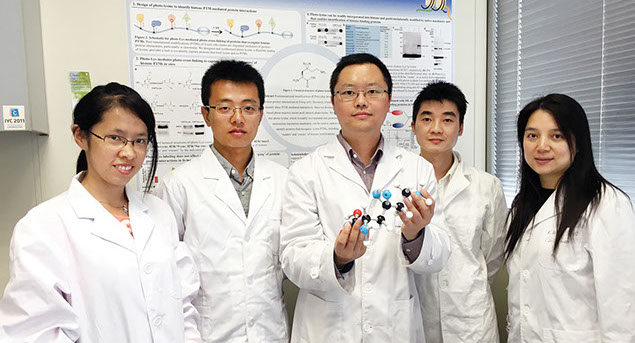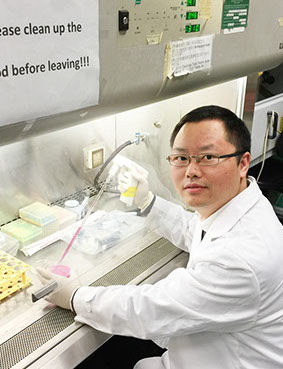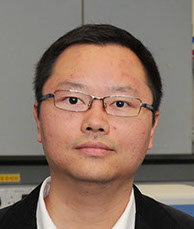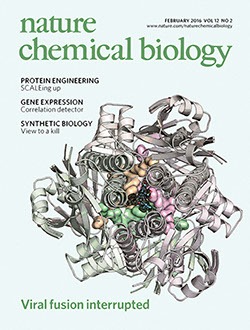
Dr Li’s research team – (from left) Miss Bao Xiucong, Mr Li Xiaomeng, Dr Li Xiang David, Dr Yang Tangpo and
Dr Eva Fung Yi-man.

Deciphering Protein Interactions
A chemical tool has been developed to study protein interaction within a cell, giving hope for understanding the disorders in cellular networks that can spark severe diseases such as cancer and Alzheimers.
Dr Li Xiang David of the Department of Chemistry led the research team that developed and synthesised the chemical tool– an unnatural amino acid called photo-lysine – which is sent into the cell network to survey cellular protein interactions. Put simply, it enables them to decipher complex protein networks.
“When added into the cell culture medium,” explained Dr Li, “the photo-lysine incorporates itself into the cellular proteins without disturbing normal cell function. The photo-lysine-labelled cells are then exposed to UV light for a couple of minutes to ‘trap’ all protein-to-protein interactions. This is possible because photo-lysine carries a light-activated capability, diazirine.
“Proteins interact with each other to cooperatively regulate essentially every cellular process,” said
Dr Li. “The protein-to-protein interaction may not be strong and it may not be stable, but we make it stable by trapping with a chemical bond. The interactions can then be examined and interpreted.”
When coupled with the latest mass spectrometry-based proteomics techniques, Dr Li’s laboratory were able to identify protein interactions – some known, others hitherto undiscovered – that are important for the regulation of essential cellular processes such as gene expression, signal transduction and metabolism.

Dr Li is adding photo-lysine into a cell culture dish to study protein interactions in living cells.
Mapping proteins and their interactions has until now been a fundamental challenge in modern biology, and the implications are far-reaching as the tool has applications for many areas of study, as well as for disease diagnosis and therapy.
“This method can be used to study whatever protein you want for whatever purpose,” said
Dr Li. “It’s a very useful research tool, which crosses myriad fields of research and can be used for long-term study. Already, many laboratories have asked us for photo-lysine– we’ve had requests for the compound from the US, Germany and Mainland China.”
Dr Li’s laboratory is focussing on taking a chemical approach to discovering biology. “Biology is very complicated, chemistry is too,” he said. When traditional biological methods don’t work, chemical methods may shed new light on our understanding of its complexity.”

![]() It’s a very useful research tool, which crosses myriad fields of research and can be used for long-term study. Already, many laboratories have asked us for photo-lysine – we’ve had requests for the compound from the US, Germany and Mainland China.
It’s a very useful research tool, which crosses myriad fields of research and can be used for long-term study. Already, many laboratories have asked us for photo-lysine – we’ve had requests for the compound from the US, Germany and Mainland China. ![]()
Dr Li Xiang David
Chemical epigenetics
The laboratory is using this method to further explore histone epigenetics, which looks at the biological significance of histone modifications. Histone proteins serve as a structural scaffold for DNA packaging, and modifications of histones play key roles in the regulation of gene expression, repairing damage to DNA and other cellular processes involving access to DNA.
“What makes cells in our bodies so different from each other, given that they have same DNA? For example what makes a stem cell a stem cell, a neuron a neuron?” said Dr Li. “This question is important, not only because it tells us the fundamental mechanism that controls the normal function of our body, but also it has implications for why and how we may have severe diseases such as cancer.
“DNA is highly compact, it is wrapped around histones. A variety of modifications are present on histones. These modifications can serve as a heritable ‘code’ (so-called ‘histone code’), which provides information that a mother cell can pass to its daughters. Histone code is ‘written’ or ‘erased’ by enzymes, while ‘readers’ of histone code recognise specific histone modifications and ‘translate’ the code by executing distinct cellular programs necessary to establish the diverse cell phenotypes (for example, to make a neuron a neuron and a stem cell a stem cell). So the question is: what recognises what? To decode histone code we need to look at the protein-to-protein interactions and capture the interaction partners – hence the use of photo-lysine.”

Dr Li’s findings were published in the February 2016 issue of Nature Chemical Biology.
Such is the scope of photo-lysine applications that there has already been much interest in
Dr Li’s research, including from some areas he was not expecting. ”People in the School of Public Health have asked me to give a talk to a group of virologists,” he said. “Because of SARS, there is particular research interest in Hong Kong in infectious diseases. Since the first step of infection is interaction between cells,
photo-lysine may be able to help determine questions such as, which are the receptors of SARS/flu, and how does the bacterial or viral cell interact with the human cell when the infection happens? What is the interaction?” Hopefully, photo-lysine may help answer many questions concerning pathogen host interaction.
Dr Li’s findings were recently published in a
top-class scientific journal Nature Chemical Biology.

